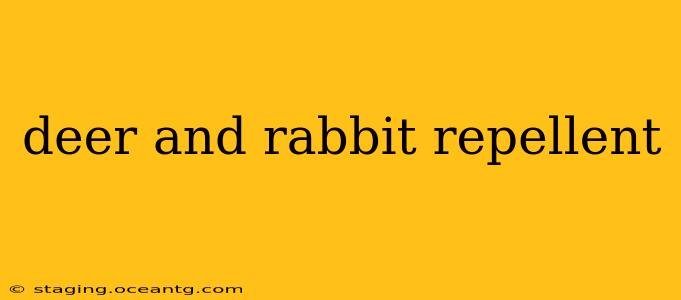Deer and rabbits can wreak havoc on gardens, leaving behind chewed-up plants and frustrating gardeners. Choosing the right repellent is crucial for protecting your precious blooms and vegetables. This guide explores various deer and rabbit repellent options, addressing common concerns and helping you choose the best solution for your needs.
What are the most effective deer and rabbit repellents?
The effectiveness of a repellent depends on several factors, including the type of animal, the severity of the infestation, and the specific product used. Generally, repellents fall into several categories:
-
Scent-based repellents: These utilize strong smells that deer and rabbits find unpleasant, deterring them from entering the area. Common scents include garlic, peppermint, and putrid egg solids. The effectiveness can vary; some animals may get used to the scent over time, requiring reapplication and possibly rotation with different products.
-
Taste-based repellents: These repellents contain bitter or unpleasant-tasting ingredients that make plants unappealing to eat. They often work in conjunction with scent-based repellents for a combined effect.
-
Commercial repellents: Many commercially available products combine scent and taste deterrents, often with added ingredients to enhance their effectiveness. Always read the label carefully to understand the active ingredients and application instructions. These often need reapplication after rain.
-
Physical barriers: While not strictly repellents, fences, netting, and other physical barriers provide effective protection, especially for smaller gardens or high-value plants.
How often should I reapply deer and rabbit repellent?
The frequency of reapplication depends heavily on weather conditions. Rain will wash away many repellents, requiring more frequent application, often after each rainfall. Some products are formulated to last longer than others, and the product label should provide guidance on reapplication frequency. Generally, weekly or bi-weekly application is a good rule of thumb, especially during periods of heavy rain or if you notice increased animal activity.
Are there any homemade deer and rabbit repellents?
Yes, several homemade repellents can be effective, often leveraging natural scents that deter animals. These often require more frequent application than commercial products. Common ingredients include:
- Garlic spray: Combine crushed garlic with water and spray liberally on plants.
- Peppermint oil spray: Dilute peppermint oil in water and apply similarly to garlic spray.
- Soap spray: Dissolve dish soap in water and spray to deter animals through a sticky residue and unpleasant taste.
- Hair and human urine: Placing human hair or urine around plants can act as a deterrent due to the strong scent.
Remember, the effectiveness of homemade repellents can vary, and consistent application is key.
What are the best ways to keep deer and rabbits out of my garden?
A multi-pronged approach is often the most effective. This involves:
- Combining repellent types: Use scent and taste repellents together for enhanced protection.
- Regular reapplication: Follow the instructions on your chosen repellent carefully, and reapply frequently, especially after rain.
- Physical barriers: Use fences, netting, or other physical barriers to protect vulnerable plants.
- Plant selection: Choose plants that deer and rabbits are less likely to eat. Research plants known to be resistant to deer and rabbit damage.
- Cleanliness: Keep your garden free of fallen fruits and vegetables which can attract animals.
By implementing these strategies, you can significantly reduce the damage caused by deer and rabbits and enjoy a thriving garden.
Do deer and rabbit repellents work?
The effectiveness of deer and rabbit repellents varies widely. Some commercial products and even homemade solutions work well for certain animals and garden situations. However, no single repellent is a guaranteed solution, and animals can sometimes adapt and overcome the deterrents. The most successful approach usually combines several methods, including using repellents, creating physical barriers, and selecting plants that are less appealing to these animals.
Are deer and rabbit repellents safe for pets and children?
Always check the product label to ensure the repellent is safe for pets and children. Some repellents contain chemicals that can be harmful if ingested or inhaled. If you are using homemade repellents, ensure the ingredients are non-toxic. Keep repellents out of reach of children and pets. If you have concerns, consider using safer alternatives or physical barriers.
This comprehensive guide offers a starting point for protecting your garden from deer and rabbit damage. Remember that consistent effort and a combination of strategies are usually necessary for the best results. Experiment with different methods to find what works best in your unique situation.
